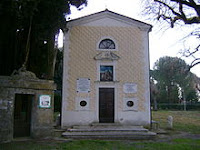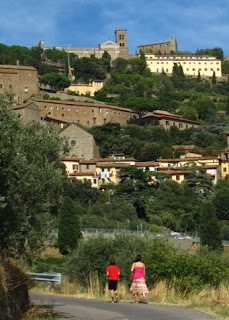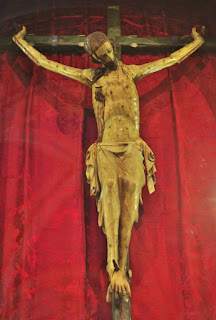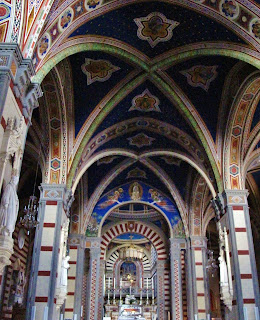Cortona Tuscany's beloved patron Saint, Santa Margherita, is a life story of devasting loss, repentance and renewed purpose. How did this simple country girl go from Sinner to Saint?
 |
| Laviano Church |
Margherita Bartolomeo was born in 1247 in a small village called Laviano halfway between the hilltown fortress of Montepulciano and the lakeside Castle of Castilogne di Lago on Lake Trasimeno. The tiny hamlet consists of a few buildings that are now agriturismos and an 11th Century church called Church of the Saints Vito and Modesto. It is said that Margherita came to this chapel to pray daily as a child. Across from the ancient church is a small cottage that has room for animals on the ground floor and living quarters above. Margherita is believed to have been baptized in St. Peters Church in Pozzuolo, a nearby town. Margharita lived a happy life with her parents and younger brother until her mother died when she was a girl of about seven, and then her life turned upside down.
Margherita's father remarried rather quickly to a woman who was not very kind to her step-daughter. According to legend, Margherita constantly fought with her step-mother and was described as "willful," "stubborn," "disobedient," and "reckless,"; which is code for Margherita had a mind of her own and can not be tamed! Soon, Margherita flowered into a stunning young woman, and word of her beauty spread far and wide over the Val di Chiana. This combination of beauty and fearlessness was a recipe for disaster for a woman who spoke her mind in the Middle Ages.
 |
| Maria Frau in Margherita da Cortona |
As word of Margherita's fairness travelled, a son of the nobleman Gugliemo del Pecora heard of the young peasant girl's beauty and wanted to see her for himself. The del Pecora family were extremely powerful nobles in Montepulciano and had palaces in Montepulciano, Chiusi and Valiano, a small town on the Umbrian border. The son of Gugiemo del Pecora was Raniero (sometimes called Arsenio in texts, now thought to be an anagram) who had a hunting villa in the hills just outside the village of Valiano. When he went out hunting, he would seek out the beautiful young Margherita, and a torrid affair began.
 |
| The Fortress Like Hunting Lodge |
Rumours abounded about the liaison between the peasant girl and the nobleman, and Margherita's family was worried about shame being brought upon them. Just like Romeo and Juliet, you know that when you try to stop two star-crossed lovers, only tragedy prevails. Margherita was forbidden to see Raniero, and the fifteen-year-old ran away to live with him. The legend says that poor Margherita was locked up in a tower in Raniero's castle in Montepulciano and tricked into being his concubine. There was NO WAY Raniero's family would have been happy with his choice of lover. Raniero would have to marry a noble, and in fact, was already betrothed to a noblewoman from Siena. He kept his delicious little Margharita safe from the wagging tongues of the courts of Montepulciano, away from his disapproving father's castle in Valiano and tucked her away just outside the city walls in his fortified tower aka~The Hunting Lodge.
 |
| Marco Benefial |
 |
| Votive Chapel of Saint Margaret |
Margherita's word came crashing down on her, and she fell to her knees at the sight of her dead lover. She believed she was being punished for her happiness and thought God judged her lifestyle to be a sin. Raniero was caught up in the Guelph-Ghibelline feuds, and his murder was a direct message to the powerful del Pecora family. Margherita was distraught and repented all her sins to God in that forest grove of Oaks. The faithful have been going to this spot ever since, and a votive chapel was built in there in 1750. In front of the tiny church was a vast 1000-year-old Oaktree called "the Oak of Repentance," the very same Oak Margherita prayed under. Just in the past year, the Oak Of Repentance has fallen over, and the trunk of the tree has been preserved and erected in front of the votive chapel. Every year at the beginning of September, the faithful gather here to worship Santa Margherita.
 |
| Oak Of Repentance |
Gathering up her son Jacopo, Margherita fled her home for the past ten years and left everything behind. She knew Raniero's family disapproved of her and Jacopo, and Margherita may have even suspected his family may have been involved in his murder. Margherita and her boy returned to her childhood home, only to find her father has disowned her and refused to let them in. Margherita, devastated, then headed to Cortona, some 18 km away.
 |
| Cortona From The Valley Floor |
Arriving in Cortona in 1272, Margherita and Jacopo are taken in by Countess Ranieri and her sister Lady Maineria De Moscari in the Palazzo Moscari (now a private home). These two noblewomen helped the single mother to get back on her feet, and it is thought that perhaps Margherita knew the two them from her life with Raniero. Maineria and Ranieri arranged to have Jacopo educated in Arezzo so that Margherita could focus on putting her life together again. Margherita was still a beautiful woman of around 25 years old at this time in her life and decided to devote her life to helping the poor. Margherita began to spin wool and flaxen, while the noble De Moscari sisters also got Margherita some work as a midwife (which she was very successful at.) They also set Margherita up in a small apartment near the Porta Berada, which is located on Via S. Margherita as it leaves the city to go up to the basilica.
Cortona
has been ravished by the battles with Arezzo in the late 1250s, and there were
many homeless, sick and poor people barely existing. Margherita prayed fervently every day before the wooden crucifix in St Francis's church, the same one Saint Francis
used to pray before. One day Margherita heard the words, "What is your
wish, Poverella?" Poverella in Italian means
"little poor one," and Margherita replied, "I neither seek nor
wish for anything but YOU." This nickname Spirit gave Margherita
stuck, and she went to work nursing the sick and feeding the poor. By the
year 1278, Margherita's wealthy friends, the De Moscari sisters, opened up their
palazzo to establish a hospital, "Our Lady Of Mercy," run solely by
her order of tertiary sisters that were nurses called Le Poverelle. Today the wooden crucifix is housed in Cortona's basilica of St. Margherita.
 |
| Shrine in Cortona |
 |
| St. Margherita Basilica |
The deserted oratory of St. Basil at the top of Cortona just
below the Medici Fortress was given to Margherita in 1288 by the Catholic
Church. The little chapel only measuring 15 meters long was severely damaged
during the 1258 siege of Cortona by Arezzo. Margherita chose this
little chapel because of the adjacent convent that she rebuilt to house
her Poverelle which had outgrown the Moscari
Palazzo. Margherita lived in a small room behind the
church while she personally oversaw the restoration of the convent and church.
At the age of 50, Margherita began to slow down, and the days
of hard labour and poverty diet had taken a toll on her body. Her
confessor, Friar Giunta Bevegnati spent eight days writing down
Margherita's Vita and a few years after her death and she was
presented as "The New Magdalene." February 22, 1297, Margherita da Cortona died in
her small room at the back of her church, and her body was buried in the wall.Baroque Interior Of Saint Margherita Basilica
 |
| Final Resting Place Of Saint Margherita da Cortona |
After Margherita's death, her popularity grew exponentially. A bigger church was needed, in part to hold her relics and also to house all the pilgrims coming to Cortona. In 1456 her body was disinterred and was discovered to be incorrupt-her body had not decomposed. In the Catholic Church, this is considered Supernatural, a miracle and the sign of a Saint! On May 16, 1728, Margherita da Cortona was canonized, and her body was placed inside a silver and glass casket designed by famous Baroque painter Pietro Berrettini (Pietro da Cortona). You can view Margherita's body, which is on display behind an iron gate in the marble side-chapel of the basilica.

It doesn't matter who you used to be; what matters is who you decide to be today.






No comments:
Post a Comment